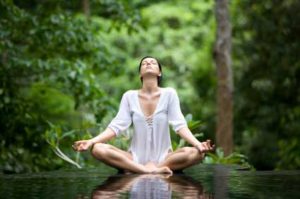Relaxation methods are crucial in dealing with anxiety disorders. I will address five anxiety coping techniques that can be used to increase energy, focus, and memory, to reduce insomnia and prevent cumulative stress. The more you practice these techniques, the more quickly and automatically you will be able to use them when you are in a tense situation.
Deep Breathing
It is one of the most used anxiety coping techniques. It is simple and can be practiced almost anywhere. Take a deep, full breath from your abdomen below your ribs (your hand should rise, and abdomen should expand), pause briefly (count to three), then exhale slowly and thoroughly. While you are breathing deeply, you might also slowly repeat calm words such as “Take it easy” or “Relax.” Give breathing your full attention. Repeat this exercise ten times. You can practice two or three sets of deep breathing to achieve relaxation. It takes five minutes to reduce anxiety and give you a sense of control over your response.
Progressive Muscle Relaxation (PMR)
Find a quiet environment, take a comfortable position (lying down or sitting up), have an empty stomach and comfortable garments, and practice daily twenty to twenty-five minutes. Tense each muscle group for seven to ten seconds and then relax it abruptly for fifteen to twenty seconds. For example: clench your fists for seven minutes and rest for fifteen minutes; tighten your biceps and triceps and then relax. Wrinkle up forehead and the muscles of your face. Relax. To tighten shins, pull your toes and feet up toward your face, hold, and then relax. Continue stretching and loosening your jaw, neck, shoulders, chest, stomach, lower back, buttocks, tights, and calves. If a particular muscle group is still tight afterward, you can repeat the technique two to three times with those muscles. Taking a thirty seconds break between each cycle is essential.
Imagery
Visualize a safe and special place where you can take yourself when feeling anxious, angry, or stressed-out. The peaceful scene (e.g., a beach, a forest) can be either from your memory or your imagination. While you are engaging in this exercise, notice as many sensory details as you can, such as the time of day, the colors, the air temperature, texture, sounds, and any people or animals present. Once you find or create your peaceful scene, you can practice it with other relaxation strategies. This exercise is beneficial as a way to destruct yourself from anxious thoughts and phobias.
Relaxing Music
To mitigate anxiety, listen to soothing music while driving or walking the dog, or use it as a background while at home or work. Also, you can put the radio on when in the shower. Music is a handy and powerful anxiety management technique. Listening to calming music helps the mind slowing down, relaxing your body and improving your mood. It can help decrease your heart rate, the pulse, and blood pressure and increase your ability to think and remember. You can find comforting and soothing different kind of music such as classical music, the sounds of nature, light jazz, or Indian stringed-instruments.
Yoga
This tool can be powerful to help you unwind and free you from anxiety. There are many different types of yoga practiced in the United States. The most popular is Hatha Yoga that incorporates physical positions, directed and controlled breathing exercise, and meditation. Based on your preference and physical ability, you can choose gentle or more challenging yoga and do it alone or with a group.
The more you practice these anxiety coping techniques, the more automatically you will be able to use them when you are in a tense situation.

